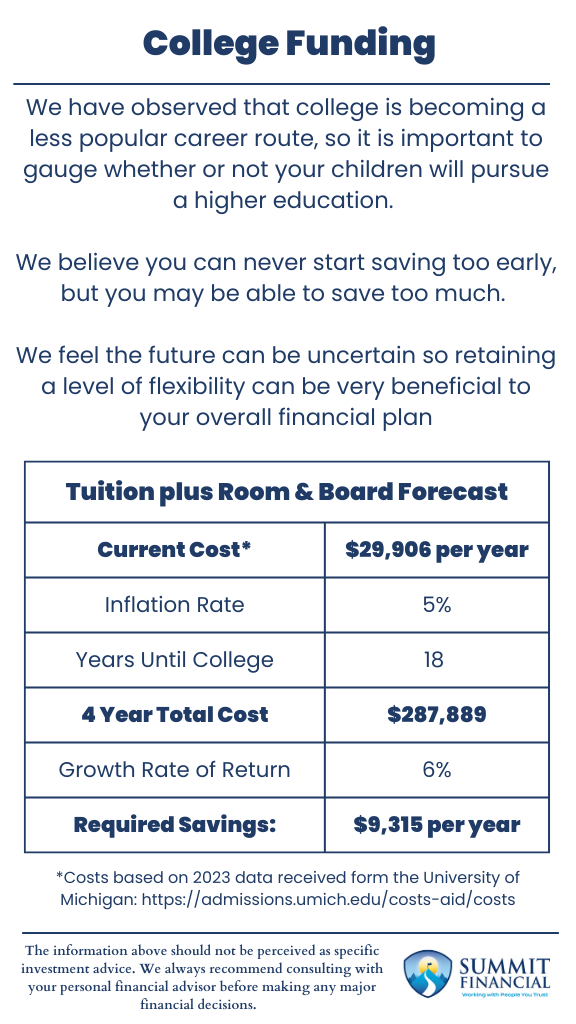In our opinion, a college education can easily be one of the most important financial decisions of your and your children’s lives. We believe a higher education has been the primary route to secure a successful future and the costs associated certainly reflect that importance.
A big part of this issue is the inflationary costs of a college education, so we often use a higher-than-normal inflation rate when running projections. We tend to lean towards a 5% inflation rate rather than the broader 2-3% inflation rate of the overall economy.

The Rising Cost of College: A Real-World Example
In 2023, The University of Michigan cost about $16,736 per year for tuition and roughly $13,170 for room and board. This puts the total per year cost at about $29,906 and assuming a 4-year degree, the total cost of college may be around $119,624.
It is important to note that not every student will choose to live in the dorms every year and off campus housing may be more affordable. Some students may also decide to attend a community college or decide to live at home for a couple of years.
Also, we have seen that many students are taking a fifth year to finish their degree so these estimates can certainly fluctuate per student.
Saving vs. Investing: What Does It Take to Reach the Goal
Typically, parents do not start to think about saving for college until their child is born, which is a logical thought process. This means that, on average, parents may have at most 18 years to save for their child’s future education.
If we apply the assumed 5% inflation rate for 18 years, the total cost of an education at the University of Michigan might end up being roughly $287,889.
This is a huge expense that some parents might not be prepared for, and this could be a detrimental burden if the student takes the full amount in student loans.
earned a negligible amount of interest, then the parents would need to save about $16,000 per year for the 18 years to hit this goal. However, there are other options available that offer more growth potential, but more growth tends to include more risk. This means that if the savings were invested, then there is a chance the accounts could lose money.
To learn more on this topic, check out our article on understanding sequence of returns risk.
If we assume a modest 6% rate of return, then the savings could outpace the college inflation rate by 1% per year, which makes quite a difference over 18 years.
This rate of return would only require about $9,315 per year to be saved. The remaining amount would be realized as part of the 6% growth to hit the desired level of college savings. As always, starting to save earlier provides the opportunity to realize more compounding growth.
College Savings Plans: How 529s Stack Up
There are a few different college savings programs that can be utilized, including the most well-known option: 529 Plans. A 529 plan is a college savings plan that allows the parents to receive up to a $10,000 Michigan state tax deduction for contributions, the funds will grow tax deferred within the account, and withdrawals for education are made tax-free.
However, withdrawals for non-education expenses will incur a 10% penalty on top of the income taxes that will be due.
So, these accounts are great for education savings but not great for flexibility. 529’s will begin to allow a limited Roth IRA conversion starting in 2024, so a portion of the funds can be converted to retirement savings for the beneficiary.
Alternatively, the beneficiary can be updated, and the funds can be used for someone else’s educational expenses. 529 or other college savings plans are obviously geared towards setting aside funds for future education expenses. That is where we believe these accounts shine the most, but they will lack flexibility for other types of expenses.
What If Your Child Doesn’t Go to College?
We are beginning to see a decline in demand for a college education as employers become increasingly focused on acquired skills rather than a formal diploma. So, what happens if your child does not go to school?
Well, the options would depend on how the funds were saved. We think the most flexible type of account would be a non-qualified brokerage account. The performance would be dependent on the underlying investments within the account, similar to a college savings plan; however, there are usually more investment options available within the brokerage account.
The parents would remain fully in control of the assets, but they would also be responsible for any capital gains taxes incurred from the investments.
These savings would be available, though, in case of a drastic emergency or a change of plans for your financial future. We believe it is essential for parents to evaluate their child’s likelihood of attending college and to develop a plan that balances college tax savings with non-qualified flexibility.
Balancing College Savings with Retirement Planning
Lastly, we would like to leave you with a figure of speech that we often use with our clients making college savings decisions.
As illustrated by the cost of college above, saving for education can have a huge impact and possibly even delay your retirement plan.
What if these assets were the make-or-break amount needed to retire on time? Parents are often forced to make this difficult decision. Is it more important to save for your retirement or save for your child’s college education?
Just like they recommend on an aircraft, we recommend securing your own oxygen mask first before assisting others. Or in financial terms, we recommend you consider securing your financial future before assisting others.
We believe this can be a tough concept for parents to grasp and rightfully so, but that is why your personal advisor is there to assist with the decision making.
Key Takeaways for Smart College Planning
- We have observed that college is potentially becoming a less popular career route, so it is important to gauge whether your children will pursue a higher education.
- We believe you can never start saving too early, but you may be able to save too much.
- We feel the future can be uncertain so retaining a level of flexibility can be beneficial to your overall financial plan.
Speak With a Trusted Advisor:
If you have any questions about your investment portfolio, retirement planning, tax strategies, our 401(k) recommendation service, or other general questions, please give our office a call at (586) 226-2100.
Please feel free to forward this commentary to a friend, family member, or co-worker. If you have experienced any changes to your income, job, family, health insurance, risk tolerance, or overall financial situation, please call us so we can discuss them.
We hope you learned something today. If you have any feedback or suggestions, we would appreciate hearing from you.
Best Regards,
Zachary A. Bachner, CFP®
with contributions from Robert Wink, Kenneth Wink, and James Wink.
If you found this article helpful, consider reading:
- Financial Planning Mistakes to Avoid
- Debt Repayment Strategies
- How to Negotiate a Raise
- Qualified vs. Non-Qualified Dividends
Sources:
- https://admissions.umich.edu/costs-aid/costs
- https://www.nerdwallet.com/article/investing/the-best-future-for-your-child-college-savings-strategies
- https://www.savingforcollege.com/article/2022-federal-tax-law-changes-to-529
- https://www.misaves.com/learn/how-does-a-529-plan-work#:~:text=Individual%20taxpayers%20may%20deduct%20up,used%20for%20qualified%20education%20expenses


